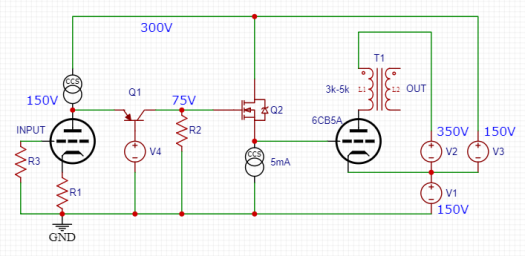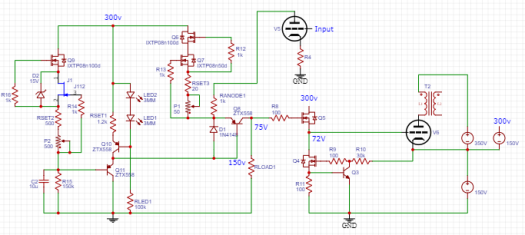I’ve had a few 6CB5As kicking around for a while waiting for a project. The 6CB5A has been documented by Thomas Mayer and Ale Moglia, among others, as a great option for triode strapping. Thing is, I like trying new things when I build and repeating a cap coupled formula for a two stage single-ended amp just wasn’t making it to my short list of projects (which I don’t quite have time for anyways).
A recent discussion reminded me of an idea to use the shunt cascode topology to direct couple to a single-ended output. It required some extra power supply rails, including a fairly large negative rail. These requirements aren’t anything too unusual; you see them with Morgan Jone’s Crystal Palace amplifier or any kind of fixed bias scheme (in a way).
Anyways, the more recent discussion reminded me of a thread discussing a novel way of direct coupling two stages by stacking the power supplies. This is kind of similar to the Free Lunch AKA Monkey on a Stick arrangement. Applying this idea to my original shunt cascode brainstorm lead me to this:

We have a shunt cascode input stage. The output resistor (R2) idles at about 75V across it. This feeds a MOSFET source follower, which will have just a couple volts less on its output. So we have a very low impedance output at around 75V above ground and we want to direct couple that to the next stage. This is where I think it gets exciting.
We raise the cathode of the output stage so that it is positive relative to the grid (at 75V) by floating the output tube power supply (V2). The voltage we float it at is roughly equal to the target bias voltage plus half the target output swing. In other words, we raise it by twice the bias voltage for A1 or twice plus a bit for A2.
The output tube anode is connected normally and the cathode returns to the point where the output supply (V2) floats on the bias supply (V1). Our input stage is powered by another supply floating on the bias supply (V3). Our input and grid driving circuits are all referenced to ground and direct coupled. We can set the output bias by adjusting the current through R2.
Here’s a more fleshed out version:

It looks like a lot in the schematic, but I’ve already got shunt cascode and grid driver circuits on small PCBs. The power supplies don’t need to be anything exotic in this case as the input has decent PSRR already. The higher current output could use simple CLC filters as well.
Will I build it? I hope eventually. By summer I hope to have the workshop basically finished. I’m already enjoying having all the tools and parts in one (heated) space!

